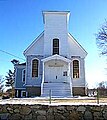
Burrillville is a town in Providence County, Rhode Island, United States. The population was 16,158 at the 2020 census.

North Smithfield is a town in Providence County, Rhode Island, United States, settled as a farming community in 1666 and incorporated into its present form in 1871. North Smithfield includes the historic villages of Forestdale, Primrose, Waterford, Branch Village, Union Village, Park Square, and Slatersville. The population was 12,588 at the 2020 census.

Samuel Slater was an early English-American industrialist known as the "Father of the American Industrial Revolution", a phrase coined by Andrew Jackson, and the "Father of the American Factory System". In the United Kingdom, he was called "Slater the Traitor" and "Sam the Slate" because he brought British textile technology to the United States, modifying it for American use. He memorized the textile factory machinery designs as an apprentice to a pioneer in the British industry before migrating to the U.S. at the age of 21.

John Fox Slater was an American philanthropist who supported and funded the education of freedmen after the Civil War.

The Blackstone Valley or Blackstone River Valley is a region of Massachusetts and Rhode Island. It was a major factor in the American Industrial Revolution. It makes up part of the Blackstone River Valley National Heritage Corridor and National Historical Park.

The Slater Mill is a historic water-powered textile mill complex on the banks of the Blackstone River in Pawtucket, Rhode Island, modeled after cotton spinning mills first established in England. It is the first water-powered cotton spinning mill in America to utilize the Arkwright system of cotton spinning as developed by Richard Arkwright.

John Slater was an early American industrialist, founder of Slatersville, Rhode Island and younger brother of Samuel Slater, father of the American Industrial Revolution, and a member of the well-known Slater family.
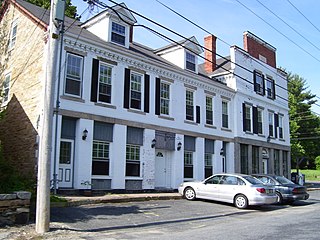
Forestdale is a village and historic district in North Smithfield, Providence County, Rhode Island, United States, one-half mile from Slatersville. The historic district runs east and west along Main Street and north on Maple Avenue. School Street is the primary road through the village, and the one-room schoolhouse for which the street is named still stands. The Branch River runs through the valley adjacent to School Street. The Village Haven Restaurant and local VFW chapter are also located in the village.
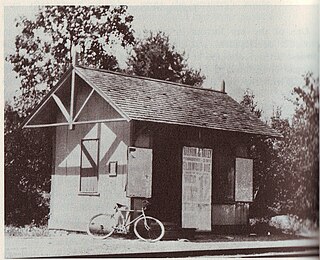
Primrose is a village in North Smithfield, Rhode Island, United States. The village is located in the area around Greenville Road and Providence Pike. The village derives its name from the Primrose railroad station, which existed on Greenville Road for the Providence and Springfield Railroad, which began service in 1873. The Primrose Fire Department and North Smithfield High School are located in the area. The historic Primrose Grange (1887) building is located on Grange Road as well as several eighteenth-century farms surrounded by stonewalls.

Wheelockville is a village in the town (township) of Uxbridge, Massachusetts, United States. Part of the village centering on Mendon and Henry streets is listed on the National Register of Historic Places as the Wheelockville Historic District. Wheelockville appears on the Blackstone U.S. Geological Survey Map. The Village receives municipal services from Uxbridge, for fire, police, EMS, School district, public works, and other services. Worcester's Judicial District includes Uxbridge District Court. The geography of Wheelockville includes several other distinct mill villages, including: Hecla and Elmdale.
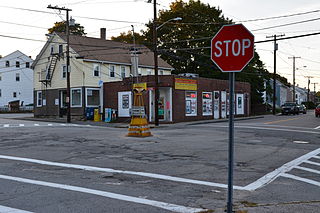
Albion is a village and historic district in Lincoln, Rhode Island, United States.
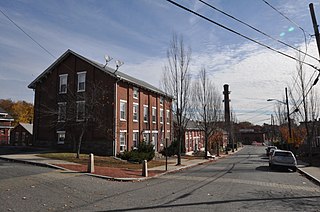
Lonsdale is a village and historic district in Lincoln and Cumberland, Providence County, Rhode Island, United States, near Rhode Island Route 146 and Route 95. The village was originally part of the town of Smithfield until Lincoln was created in the 1870s, and was originally centered on the Lincoln side of the Blackstone River. William Blaxton settled in the area in 1635. In the nineteenth and early twentieth centuries, Lonsdale was home to several manufacturers including the Lonsdale Company's Bleachery, and the Ann & Hope mill was also located in the village in Cumberland.

The Saylesville Friends Meetinghouse is an historic Quaker meetinghouse located at 374 Great Road within the village of Saylesville in the town of Lincoln, Rhode Island.

The Blackstone Manufacturing Company Historic District encompasses the "New City" or "High Rocks" area of Blackstone, Massachusetts, an industrial village associated with the Blackstone Manufacturing Company, which began operations in 1809. It includes an area roughly surrounding Butler, Canal, Church, County, Ives, Main, Mendon, Old Mendon, and School Streets. The district includes a wide variety of worker housing, as well as a granite storehouse, the only surviving company structure. The district was added to the National Register of Historic Places in 1995.

The Valley Falls Company was founded in 1839 by Oliver Chace, in Valley Falls, Rhode Island, a historic mill village on both sides of the Blackstone River, within the modern-day town of Cumberland and city of Central Falls, Rhode Island. The Valley Falls Company is the original antecedent of Berkshire Hathaway, currently one of the world's largest and most successful companies.

The Woonsocket and Pascoag Railroad was a historic railroad that operated between Woonsocket, Rhode Island and Pascoag, Rhode Island. Its remaining tracks from Woonsocket to Slatersville are now owned and operated by the Providence and Worcester Railroad.

Blackstone River Valley National Historical Park is a National Park Service unit in the states of Rhode Island and Massachusetts. The park was created for the purpose of preserving, protecting, and interpreting the industrial heritage of the Blackstone River Valley and the urban, rural, and agricultural landscape of that region. The Blackstone River Valley was the site of some of the earliest successful textile mills in the United States, and these mills contributed significantly to the earliest American Industrial Revolution. The subsequent construction of the Blackstone Canal, a few years after the successful completion of the Erie Canal, helped to sustain the region's industrial strength.

North Smithfield Public Library is a public library at 20 Main Street in the village of Slatersville in North Smithfield, Rhode Island. Part of the library is currently located in a renovated nineteenth-century stone mill building that was a mill store house for John Slater's nearby mill before it became the North Smithfield Public Library in 1966, and the library is adjacent to the Slatersville Reservoir. An extensive addition was added in the 1980s. The Library was originally founded in 1931 with the first branch in the Union Village school before eventually moving to Slatersville.

The Slater family is an American philanthropic, political, and manufacturing family from England, Rhode Island, Massachusetts, and Connecticut whose members include the "Father of the American Industrial Revolution," Samuel Slater, a prominent textile tycoon who founded America's first textile mill, Slater Mill (1790), and with his brother John Slater founded Slatersville, Rhode Island in North Smithfield, Rhode Island in 1803, America's first planned mill village. The family includes various merchants, inventors, art patrons, and socialites. John Fox Slater, was a prominent abolitionist who founded the Slater Fund and built the historic John F. Slater House and Slater Library. William A. Slater was a noted art collector and philanthropist who created the Slater Memorial Museum in Connecticut. After moving many of their mills to the South from New England, the village of Slater-Marietta, South Carolina was named after the family.






